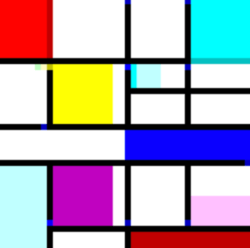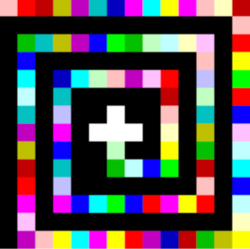This programming language gives you programs that resemble modern art. It’s fortunately a feature of the language, dubbed Piet after the famed abstract painter Piet Mondrian.
The language uses 20 distinct colors, with the colors cycling from red to yellow to green to cyan to blue to magenta and the lightness cycling from light to normal to dark. The code is formed from graphics made of the recognized colors, with individual pixels holding much of the information. Stacks are used for storing data values, that can exist as integers or as Unicode characters with the proper commands applied.

Numbers in the program are represented by colors, while black blocks indicates edges and white blocks indicate free zones. The interpreter physically slides through blocks in the direction of the Direction Pointer (DP), with hue changes indicating different commands based on the steps of the change.
To execute a program, the Piet language interpreter begins in the upper left codel (or individual code block) of the program, maintaining a DP initially pointed to the right and a Codel Chooser (CC) initially pointed to the left. The DP and CC turn right, left, down, or up depending on the execution.
There is currently a small community of coders developing sample programs, interpreters, IDEs, and compilers for the language. You can check out some of the sample programs here.


















If you like strange languages, check NeuronZoo:
https://hackaday.io/project/19287-neuronzoo
So I looked. This is interesting. The ease with which a 10-key adding machine was implemented caught my interest. The presentation as a 3d-rendered thing was also impressive; unfortunately this makes use of tricks (axons transferring their labels to others) that would make a physical implementation ..difficult. Thanks for the reference, though.
Purrfect language to write a Nyan Cat port.
It’s like turtle graphics just add LSD.
I feel like that could be a niche… BRB off to re-implement brainf**k in paisley shapes…
After reading the original article I wonder if there’s a similar language using grayscale. That could be named S.O.Gra (portuguese readers will get the pun).
I think its called brainf*ck (seriously, or something like that). Dont remember offhand if it was grayscale, but it was graphic based.
Actually, it isnt brainf*ck at all, it ascii control characters (+, -=}), etc. I do remeber a similar graphical based language that worked similar to this, but you know – weed.
Very minecraft
Isn’t this rather similar to Befunge?
RGB eye cancer programming language!
And it’s self-inflicted, at that!
The creator, David Morgan-mar is apparently also the author of the Darths & Droids webcomic. https://en.m.wikipedia.org/wiki/David_Morgan-Mar
Esolang wiki for Piet: https://esolangs.org/wiki/Piet
Looks like this HaD writer just discovered the esoteric language community. Piet’s been around since at least 2005, which is when it was added to the esolang wiki.
Maybe, but most of us unimaginative conventional coders need to be reminded of these interesting projects from time to time. It could be just an interesting diversion… or it could inspire some new projects and insights. I like this sort of article in HaD.
Euphoria is a programming language that is worth a look, if I can use it, anyone can.
Marvellous… looks all set to do for programming what 3D Printing did for shop skills ;-)
I’ll just leave this here…
https://stackoverflow.com/questions/5588649/how-did-this-person-code-hello-world-with-microsoft-paint
THAT I could actually do, maybe even Z-80 object code. But THIS? Unh-uh.
Reminds my of this tech. https://www.researchgate.net/figure/mplementation-of-LUT-using-QCA-designer-tool_fig6_316664067
The software tool can be found here, http://web.ist.utl.pt/ttt/qca-lg/index.html
Pretty sure this was covered before on Hackaday.
(Either in article, or list of links, or in comments.)
All the posters know so much but no one mentions Whitespace?
Ahh okay, so its Sim-Tunes then?
https://www.youtube.com/watch?v=r-SS8WlREPQ